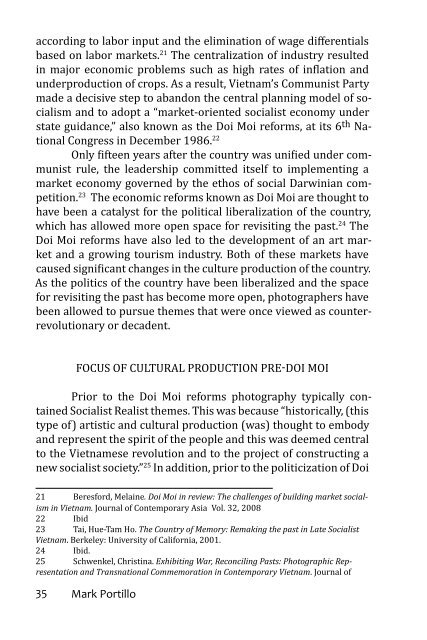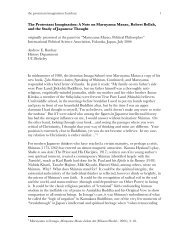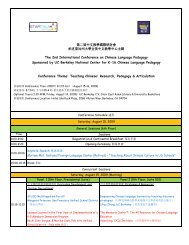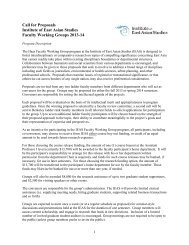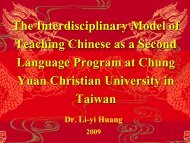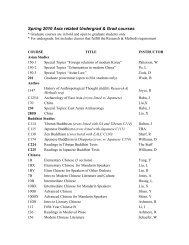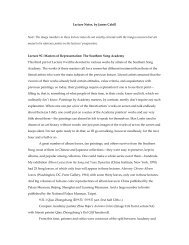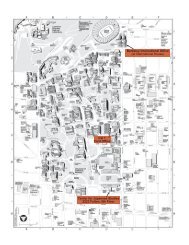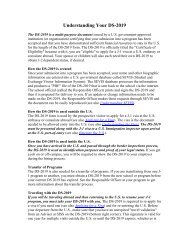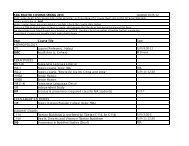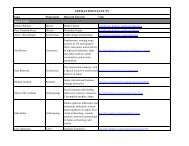Third Edition Spring 2013 - Institute of East Asian Studies, UC ...
Third Edition Spring 2013 - Institute of East Asian Studies, UC ...
Third Edition Spring 2013 - Institute of East Asian Studies, UC ...
You also want an ePaper? Increase the reach of your titles
YUMPU automatically turns print PDFs into web optimized ePapers that Google loves.
according to labor input and the elimination <strong>of</strong> wage differentialsbased on labor markets. 21 The centralization <strong>of</strong> industry resultedin major economic problems such as high rates <strong>of</strong> inflation andunderproduction <strong>of</strong> crops. As a result, Vietnam’s Communist Partymade a decisive step to abandon the central planning model <strong>of</strong> socialismand to adopt a “market-oriented socialist economy understate guidance,” also known as the Doi Moi reforms, at its 6 th NationalCongress in December 1986. 22Only fifteen years after the country was unified under communistrule, the leadership committed itself to implementing amarket economy governed by the ethos <strong>of</strong> social Darwinian competition.23 The economic reforms known as Doi Moi are thought tohave been a catalyst for the political liberalization <strong>of</strong> the country,which has allowed more open space for revisiting the past. 24 TheDoi Moi reforms have also led to the development <strong>of</strong> an art marketand a growing tourism industry. Both <strong>of</strong> these markets havecaused significant changes in the culture production <strong>of</strong> the country.As the politics <strong>of</strong> the country have been liberalized and the spacefor revisiting the past has become more open, photographers havebeen allowed to pursue themes that were once viewed as counterrevolutionaryor decadent.Focus <strong>of</strong> Cultural Production Pre-Doi MoiPrior to the Doi Moi reforms photography typically containedSocialist Realist themes. This was because “historically, (thistype <strong>of</strong>) artistic and cultural production (was) thought to embodyand represent the spirit <strong>of</strong> the people and this was deemed centralto the Vietnamese revolution and to the project <strong>of</strong> constructing anew socialist society.” 25 In addition, prior to the politicization <strong>of</strong> DoiMoi aesthetics in Vietnam it “was the duty <strong>of</strong> the artists to supportthe war effort (while) anything else was seen as unacceptably decadent.”26 The communist leadership described photography priorto the Doi Moi reforms as “using a lens to serve the struggle for theright. The representative <strong>of</strong> the right and interest <strong>of</strong> the nation atthat time was the Viet Minh.” 27 Today the country views“such images as a necessary means to educate and motivate the youth.Photography is thus imagined to bridge the widening gaps betweenthe past and the future: between generations who experienced warand generations born in its aftermath, which grew up in an era <strong>of</strong>increasing capitalist consumption and presumably no longer understandthe sacrifices <strong>of</strong> their elders.’” 28Despite the continued use <strong>of</strong> photography as a cultural productiontool in education that follows this heroic narrative, overall thecountry’s relationship with photography has dramatically changedfollowing the advent <strong>of</strong> the Doi Moi reforms.Focus <strong>of</strong> Cultural Production Post-Doi MoiThe Doi Moi reforms saved the Vietnamese communist leadershipfrom irrelevance at a time when socialist regimes throughoutEurope toppled, but the reforms also led to the integration <strong>of</strong>the country into the global economy. 29 This integration producedthe emergence <strong>of</strong> a private art market, which forced the communistleadership to re-think its relationship to photography. The reinterpretation<strong>of</strong> photography post-Doi Moi no longer emphasizedits use as a tool for supporting the revolution and teaching aboutits victories, but changed its identity altogether. Photography todayhas been redefined by the communist leadership as a means <strong>of</strong>21 Beresford, Melaine. Doi Moi in review: The challenges <strong>of</strong> building market socialismin Vietnam. Journal <strong>of</strong> Contemporary Asia Vol. 32, 200822 Ibid23 Tai, Hue-Tam Ho. The Country <strong>of</strong> Memory: Remaking the past in Late SocialistVietnam. Berkeley: University <strong>of</strong> California, 2001.24 Ibid.25 Schwenkel, Christina. Exhibiting War, Reconciling Pasts: Photographic Representationand Transnational Commemoration in Contemporary Vietnam. Journal <strong>of</strong>Vietnamese <strong>Studies</strong> 3.1, 2008.26 Tai, Hue-Tam Ho. The Country <strong>of</strong> Memory: Remaking the past in Late SocialistVietnam. Berkeley: University <strong>of</strong> California, 2001.27 Ibid.28 Schwenkel, Christina. Exhibiting War, Reconciling Pasts: Photographic Representationand Transnational Commemoration in Contemporary Vietnam. Journal <strong>of</strong>Vietnamese <strong>Studies</strong> 3.1, 2008.29 Ibid.35 Mark Portillo Constructing “Culture” 36


